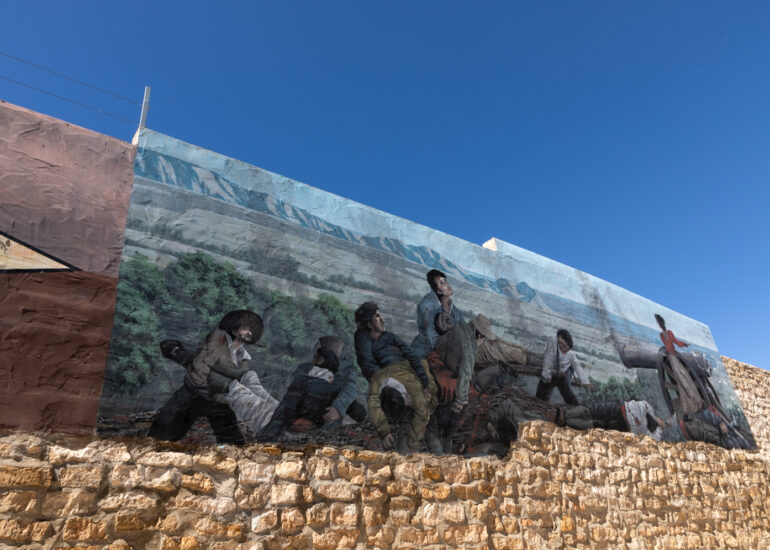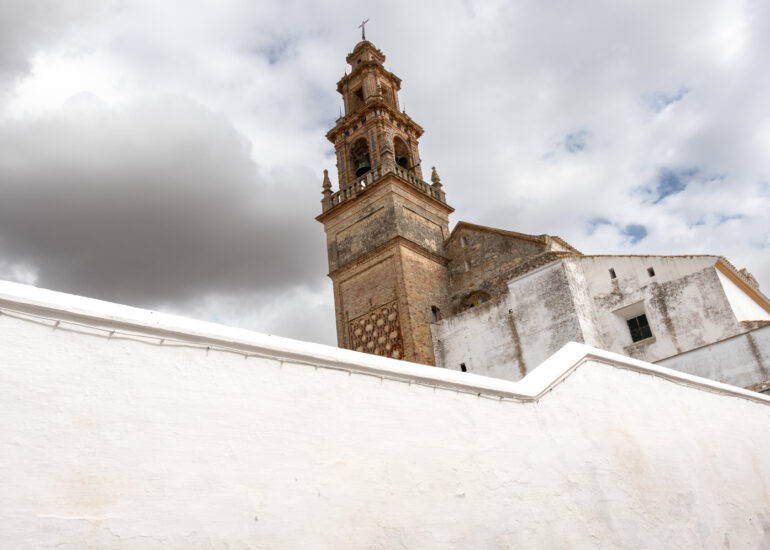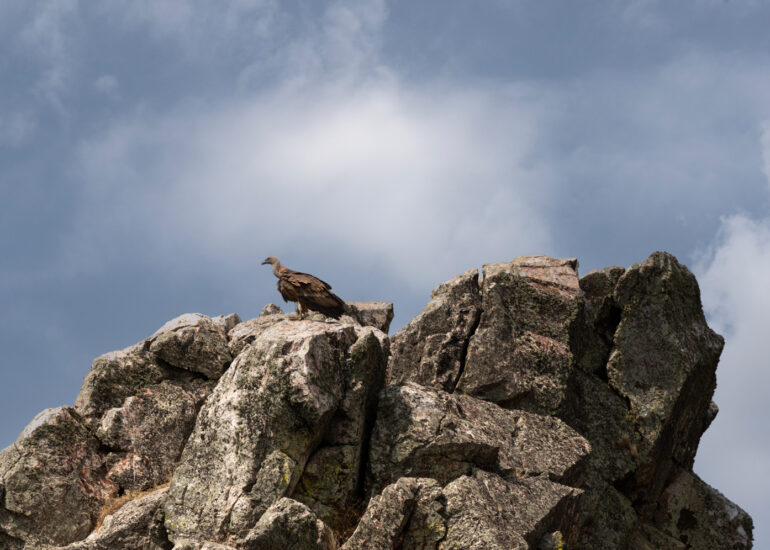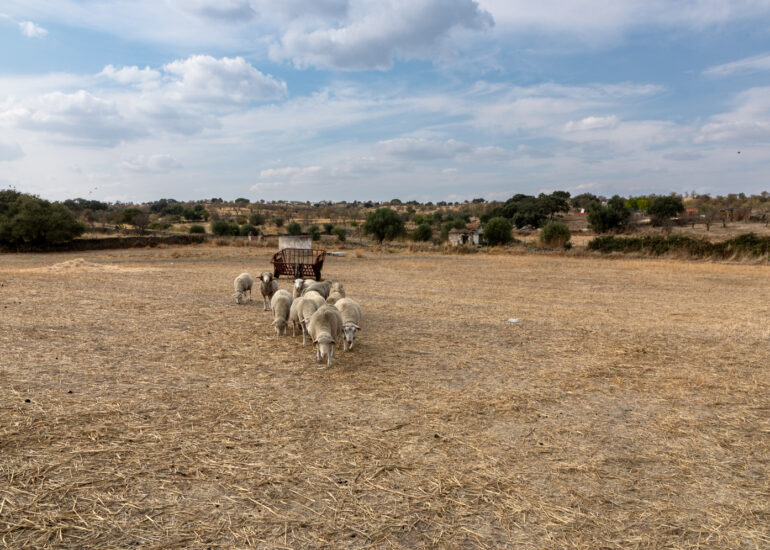Travelogue France and Spain 2024 (II)
travelogue
France and Spain 2024 (II)
In part I we reported on our journey through Belgium and France to the Spanish border. In this part we continue our journey and make a round trip in Spain. This is our sixth round trip with our buscamper in Spain and we still have a lot to explore in this beautiful imposing country.
We drove about 7.130 km during this trip
Photo series
We are in the process of uploading our photo’s of Spain. These photo’s are incorporated in the Regional series in our Spain folder (click). Here below a small selection of our photo’s, meant as a teaser
Please note that when you click on the green headings above the paragraphs of the highlights of our trip, you will be directed to the pertinent photo series on our photo website SmugMug.
Route
- Vielha – Huesca
- Huesca – Las Bardenas – Arguedas
- Arguedas – Veruela – Belchite
- Molina de Aragón – Terzaga – Checa – Naguera – Albarracín
- Albarracín – Cascade Batida – Cuenca
- Cuenca – Alarcón
- Alarcón – Murcia – Huércal-Overa
- Huércal-Overa – Parque Natural Cabo de Gata – Cabo de Gata
- Gabo de Gata – Nijar – Sierra Alhamilla – Lucainena de las Torres – Padules
- Padules – Alpujarras (Sierra Nevada) – Órgiva
- Órgiva – Loja – Iznájar – Rute – Cabra
- Cabra – Zuheros – Montoro – Medina Azahara (Cordoba)
- Cordoba – Almodóvar del Rio – Palma del Rio – Carmona
- Carmona – Sevilla – Mérida
- Mérida -Parque Nacional de Monfragüe – Plasencia
- Plasencia – Coria – Garrovillas – Mata de Alcántara – Alcántara
- Alcántara – Membrio – Carbajo – Santiago de Alcántara – Herrera de Alcántara – Cedillo – Alcántara
- Alcántara – Brozas – Alburquerque – Valencia de Alcántara – Alcántara
- Alcántara – Plasencia – Salamanca
- Salamanca – Burgos – Bayonne (FR) – Pissos
- Pissos – Bordeaux – Poitiers – Tours – Broglie
- Broglie – Rouen – Zeeland
Map of Spain with photo locations
Highlights of our trip
Las Bardenas Reales is a semi-desert nature reserve, or badlands, of about 42,000 hectares in southeastern Navarra. The soils are made up of clay, chalk and sandstone and have been eroded by water and wind, creating surprising shapes, canyons, plateaus, tabular structures and isolated hills called cabezos.
The mesmerizing gorges and plateaus look almost lunar-like. Bardenas Reales has no urban areas, vegetation is sparse, and the many streams that cross the area have a distinctly seasonal flow and remain dry for most of the year. In recent years, it has become more popular among tourists due to the appearance of this place in the TV series Game of Thrones.
We did a lot of photography. The light with the beautiful cloudy skies was a bonus for us photographers. At the Ermita Virgen de Yugo we found a camper spot with a magnificent view.

Founded in 1145 by Don Pedro Atarés, Señor de Borja, the Monastery of Veruela (Royal Monastery of Santa María de Veruela) was the very first Cistercian monastery founded in La Corona de Aragón (Crown of Aragon). In fact, the Cistercian monks moved here in 1171 and the consecration of the abbey took place in 1248 by the bishop of Calahorra.
The monastery is impressively large. The complex consists of the abbey church and a beautiful cloister.
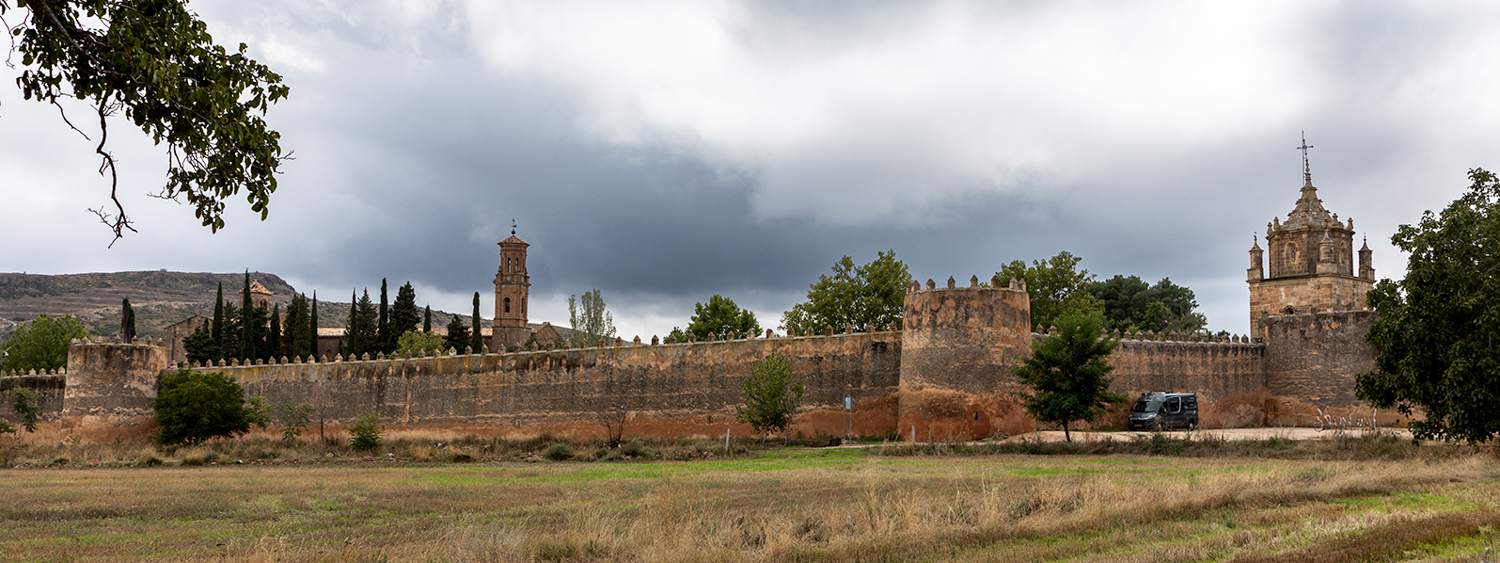
Belchite is a city with a long history, with the first settlements being established there as early as 75 AD. Over the centuries, it was built with beautiful medieval churches and monuments such as the Arch of San Roque.
But everything changed with the outbreak of the civil war in Spain (guerra civil) in 1936. Belchite, on the border between the republican state and the fascist troops, became the scene of one of the bloodiest and most important battles of the entire war. The city was initially in the hands of the Nationalist army after General Francisco Franco’s coup d’état, but was captured by the rebels in 1937 during a fifteen-day siege that almost destroyed the village.
In the Battle of Belchite, the houses were shot to pieces, the churches razed to the ground, and the townspeople massacred.
When Belchite was recaptured by Spanish dictator Franco in 1938, he left it as a reminder of his awesome, brutal power and as a warning to anyone who tried to thwart him. Today, the city is still there, but rather serves as a reminder of the futility of violence and its human cost. Although parts of the city have been rebuilt and 1,600 people live there, many parts of it are still as they were during the war.
It was here that Francisco Goya y Lucientes was born on 30 March 1746. We visited the house where Goya was born and the Museo de Grabados. The museum has many fine engravings by Goya. Fuendetodos is a sweet village to stroll through. There are also some very nice murals to admire.
Molina de Aragón
The castle, which is the face of Molina de Aragón, is worth a visit. The castle was built in the tenth century by the Moors.
High above the Río Guadalaviar, in a meander, lies the former Moorish kingdom of Albarracín.
Albarracín, with its picturesque fortifications, churches and houses on a high rocky cape carved by a loop of the Río Guadalaviar, is one of the most beautiful villages in Spain. Its unique medieval history as an independent mini-state, and the story of its resurrection from near-abandonment over the past 60 years, add to its fascination.
The more than 1000-year-old village is protected by fortress walls, which extend over the surrounding mountains.
We took a walk through the narrow streets and on the walls. It was climbing and scrambling. The fortress walls are reminiscent of the Great Wall of China. From the top you have a beautiful view of the village.
Cuenca
From Albarracín to Cuenca was a beautiful drive through the mountains. Along the way there were a few interesting “stops”
- Daroca
- Cascade Batida, a small but beautiful waterfall
- Source of the Tagus River
- Devil’s Window
Cuenca Province, the capital of the province of Cuenca, in the autonomous community of Castile-La Mancha. It is located on a pyramid-like hill above the confluence of the Júcar and Huécar rivers. Originally Roman Conca, the city was conquered from the Moors in 1177 by Alfonso VIII of Castile, who made it an episcopal seat in 1182. It served as a cultural and textile center in the Middle Ages. In the 19th century, the city expanded into the nearby lowlands and effectively became two cities: the upper, old town and the lower, modern city close to the railway line from Madrid. Seen from below, the Casas Colgantes (“Hanging Houses”) of the old town appear to have been suspended. The old town was designated a UNESCO World Heritage Site in 1996.
The highlights for us were: Plaza Mayor, the cathedral, the Puente de San Pablo and the Hanging Houses.
Alarcón is a small village, a gem, beautifully situated on a rock in a bend of the river Júcar. During the golden hour we walked through the village. The light was magic. The village has beautiful streets and churches with beautiful doors and portals.
The castle, which now houses a parador is intact and is the eye-catcher of the village. To get to the village you must go through two gates of the castle, which we found very special.
With the camper we were on an idyllic square in the middle of the village. Alarcón is a village that we would like to visit again on our travels through Spain.
We made a tour in the park. The park covers an area of 38,000 acres. It is located along the east coast near Almeria on both sides of the cape of Gata.
The scenery is quite beautiful. Mountainous, a coast with steep cliffs, but also large sandy beaches. Unfortunately, the villages are no longer the romantic fishing villages of yesteryear, but tourist villages without a soul.
The road to the lighthouse of Cabo de Gata is spectacular.
Around the park, the number of greenhouses made with white plastic makes a nasty impression. It mars the landscape tremendously. We saw a documentary on tv and learned that people are being exploited in these greenhouses to provide cheap food to the rich countries in the EU. The EU knows this is happening but does nothing about it.
Lucainena de las Torres
Lucainena de las Siete Torres (Lucainena of the Seven Towers). A place name of Iberian or Hispanic-Roman origin. It is possible the villa of the Roman aristocrat Lucainus was located here. The “de las Torres” (of the Towers) in its name refers to the castle which defended and surrounded Lucainena in the Middle Ages. It was always a strategic place for defending the route inland through the mountains from the coastal regions.
We took a walk through the village. It is a lovely village with a unique romantic square. A characteristic white Andalusian village with a friendlyy atmosphere.
Its name means small lakes as there used to be springs near the village. Its origin is Hispanic-Roman, although others think its origin is Arabic. There is a great wealth of archaeological remains in the area, a sign of the settlements of other times.
A lively village, without tourists. We passed a workshop, where an elderly man was working with old tools. He was completely in his element among all kinds of materials and tools. Antique tools hung on the walls, of which he was very proud. We took pictures. It’s always nice to photograph real people.
Las Alpujarras
The region of mountain villages, known as Las Alpujarras, clings to the southern flanks of the Sierra Nevada, split by deep, sheltered valleys and gorges that run down to the Mediterranean Sea. The Alpujarra, as it is popularly called, in the singular, is famous throughout Spain for its unique mini-ecology. The terraced farmlands are constantly watered by the melting snow from above, forming an oasis of high-altitude greenery that stands in stark contrast to the arid foothills below.
The cultural importance of the region lies in the fifty or so villages, which were the last stronghold of the Spanish Muslims, or Moors. Shortly after the Castillians took Granada in 1492, all the city’s Moors were forced to convert to Christianity. Those who refused moved into the hills and settled in this remote, inaccessible area.
We took a drive through the mountains and spent the night in Órgiva.
Considered the most charataristic village of the Sierra Subbética Natural Park, Zuheros is an extraordinarily beautiful location, whose different elements blend perfectly: limestone mountains, huge olive groves and whitewashed houses.
The village itself is particularly attractive, situated at the foot of the mountains with its clean, narrow streets lined with houses that exude tradition and history, all guarded by an impressive castle Castillo Palacio de Zuheros, which stands atop a rock.
Palma del Rio
Before we were in Palma del Rio we made a stop in Almodóvar del Rio. Above the city is a beautiful castle on a mountain. We parked the camper at the foot of the castle and walked to the castle. Palma del Rio is a characteristic Andalusian village. White houses in beautifully landscaped streets.
Worth seeing: Our Lady of the Assumption, Saint Sebastian’s Hospital, Saint Francis’ church, the Almohade walls, the Andalusia square.
Carmona
Located in the centre of the country, amidst a landscape of fields used to grow cereals, it is one of Spain’s top tourist destinations. In the city one can find many interesting remains of all the civilizations that have played a role in the history of the city.
From a distance there are the Roman ramparts, which enclose a large number of interesting monuments such as the Roman necropolis, the Alcázares, the Church of San Felipe, the Church of Santa María, the Puerta de Sevilla, the Puerta de Córdoba, among many other civil and religious buildings. It is a truly monumental city and one of the most important historical and cultural centres of Andalusia.
We had a super camper spot at the Puerta de Córdoba, with a view of the Puerta and over the valley.
Parque Nacional de Monfragüe
The confluence of the Tajo and Tiétar rivers in the Cáceres region has created this landscape of holm oaks, cork trees, smooth mountains and huge rocks. The park is ecologically of great importance for its Mediterranean flora and especially for its extraordinary fauna. It is home to many protected animals, such as black vultures, black storks and imperial eagles. It’s easy to observe, but photographing birds remains a difficult discipline.
This unique national park in Extremadura has become one of the best places in Spain for bird watching. It is home to more than 220 bird species, some of which are in danger of extinction. This makes it one of the favourite places for ornithologists who have found in this park an ideal place to see some of these species with relative ease.
Plasencia
Plasencia is a walled market town in the province of Cáceres, Extremadura. Located on the banks of the Jerte River, Plasencia has a historic district that was created by the city’s strategic location along the Silver Route, or Ruta de la Plata. Since the 15th century, the nobles of the region began to move to Plasencia, which determined its current appearance.
We took a brisk walk through Plasencia. First through the park, La Isla, then through the old town. Old walls, a huge cathedral, but also charming squares and narrow streets. Plasencia is a historic city, rich in culture, architecture and history.
From Plasencia we drove via the yellow road along the Embalse de Alcántara and through Garrovillas and Mata de Alcántara to Alcántara. A beautiful route with sometimes biblical landscapes and many animals.
We stayed a few nights in Alcántara, a familiar place for us. We became good friends with two horses next to the camper site, with whom we shared our apples. See our other Spanish travelogues.
From Alcántara we took a drive through the Parque Natural del Tajo Internacional. From Alcántara we took the red road to Membrio and from there we took the yellow road to Cedillo. Villages we passed: Cabajo, Santiago de Alcántara and Herrera de Alcántara. Along the way we drove along the Tagus several times. A spectacular route.
We also made a day trip to Alburquerque. A nice city to visit and certainly the castle, Castillo de la Luna, is well worth a visit. The surroundings are also beautiful. The vastness, the emptiness, the space are impressive. At this time of year, the landscape turns golden yellow.
We spent two days in Salamanca. We had a nice camper spot close to the Puente Romana.
The city came at us like an avalanche. We were completely overwhelmed by the megachurches and other mega-buildings and monuments. It was very busy in the city. The city is alive and bustling, especially at the end of the day. The first day we spent most of our time on and near the Plaza Mayor. I thought the Plaza Mayor was one of the most beautiful in Spain.
The monumental part of Salamanca, located between the Roman bridge and the Puerta de Zamor, is on the UNESCO World Heritage List.
The second day we strolled through the streets of the historic center, past the many monumental buildings and past buildings of the university. We spent most of our time in the Catedral Nueva and the Catedral Vieja. They are huge colossal structures with an abundance of religious art and kitch. But the whole thing is impressive.
Salamanca impressed us. It is certainly one of the most beautiful cities in Spain
Travel guides
This time we took only travel guides in the Dutch language. The Michelin guides are also printed in English.
- Spanje, een reisgids – Rik Zaal
- De Groene Reisgids Midden-Spanje van Michelin
- De Groene Reisgids Noord- Spanje van Michelin
- Extremadura – Pieter Jan van der Linden
- Camperreisgids Noord-Spanje van camperreisgids.nl
- Camperreisgids Zuid-Spanje van camperriesgids.nl
Comments are closed.




